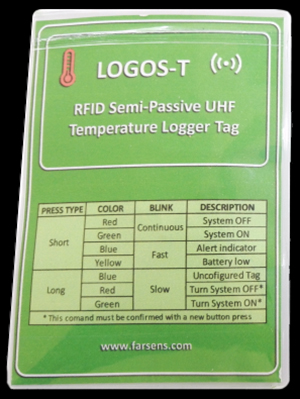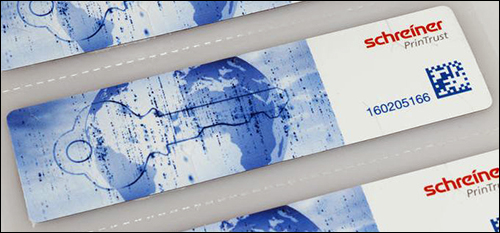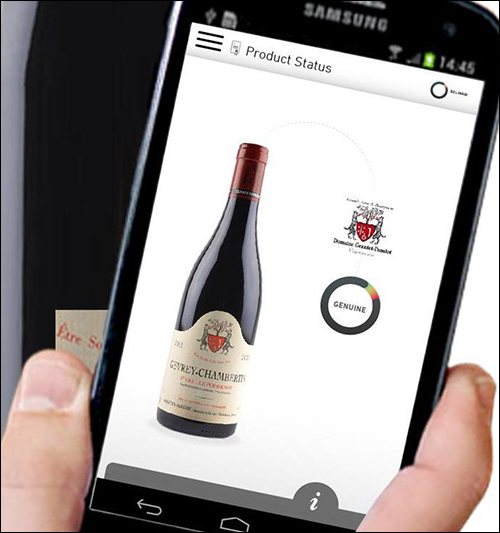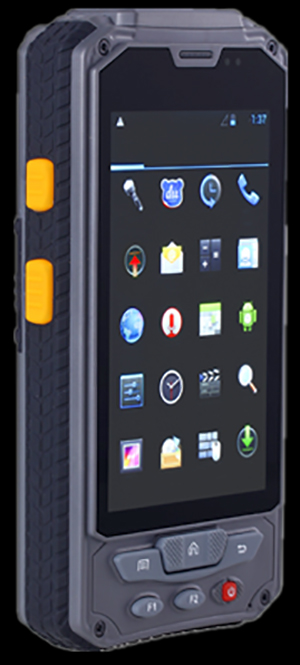The following are news announcements made during the past week by the following organizations:
Farsens; Schreiner PrinTrust; Selinko, NXP Semiconductors; IDTronic; Balluff; and Harland Simon.
Farsens Announces Prototype UHF RFID Temperature Data Logger
Farsens, a Spanish developer of RFID sensor tags, has unveiled a prototype semi-passive ultrahigh-frequency (UHF) RFID temperature data logger designed for cold-chain monitoring. The Logos-T data logger works with EPC Gen 2 and ISO 18000-6C readers, the company reports, and requires no custom commands to operate.
The Logos-T can be configured to perform temperature measurements at specified time intervals. If this function is enabled, the temperature data, along with a timestamp, can be stored in the device’s internal nonvolatile memory. The prototype is ready to be shipped, Farsens notes, though as a product under development, the Logos-T may change before being finalized, and materials, sizes and other features can be modified to suit a user’s particular application.
The Logos-T is built in a compact, PCB format and encapsulated in an IP67 housing, signifying that it is dust- and waterproof. It features a typical read range of 10 meters (33 feet) with a 2W ERP setup, as well as 128 bits of Electronic Product Code (EPC) memory and a 32-bit tag identifier (TID). The device has a temperature sensor with a range of –40 degrees to +85 degrees Celsius (–40 degrees to +185 degrees Fahrenheit), a password-protected air interface with basic encryption over the air and password-protected user data. According to Farsens, it offers a long battery life, with a typical usage time of one year.
The data logger comes with two main interfaces: RFID and manual. The RFID interface allows detailed configuration and data extraction from the device. Once the device has been correctly configured, the manual interface can be used for visual status indication and start/stop operations. A multi-color LED is included for status indication, Farsens adds, and a push button for interacting with the device in the field without the need for further equipment. In addition, the Logos-T supports several alerts that provide basic information about the tag’s status in a single read that can be performed within milliseconds, the company says.
Schreiner PrinTrust Develops High-Security RFID-enabled Windshield Label
Schreiner PrinTrust, a specialist in the fields of security and authentication, and a business unit of Schreiner Group, has introduced a new EPC ultrahigh-frequency (UHF) RFID-enabled windshield label that features advanced security. The new ((rfid))-Windshield Global Secure label is designed for toll road operators, parking lot managers and service providers in fleet management, the company reports, and closes a gap in the UHF RFID market.
Until now, according to Schreiner PrinTrust, encrypted transmissions and security chips were only possible over short ranges using high-frequency (HF) RFID technology, but the new label enables vehicles to be authenticated via counterfeit-proof security chips, thereby enabling road toll payment and access monitoring for sensitive areas. Made with NXP Semiconductors‘ Ucode DNA chip, the ((rfid))-Windshield Label Global Secure offers dynamic 128-bit AES encrypted UHF RFID communication between labels and readers. Another 128-bit AES key of the unique authentication feature ensures that only original labels are used, the company says. The label offers up to 448 bits of Electronic Product Code (EPC) memory, up to 3 kilobits of user memory and a 96-bit serial tag identifier (TID) with a 48-bit unique identifier (UID).
The Ucode DNA is a passive EPC Gen 2 UHF RFID chip that provides cryptographic authentication by using a dynamic password that changes with each read event. By requiring the verification of each password from a server, the Ucode DNA is aimed at preventing eavesdropping and tag cloning. Each tag made with the Ucode DNA chip is secured with a unique and tag-specific crypto key, and can operate in a mode in which tag response changes every time it receives a new read request from an RFID reader (see NXP Releases IC for Secure Encrypted UHF Reads).
In addition, the company says, the Global Secure label offers all known benefits of Schreiner PrinTrust’s ((rfid))-Windshield Label family, including reliable data transmission over a distance of several meters, high-quality product compound and comprehensive individualization options thanks to advanced printing procedures. Upon request, the firm can provide customized versions of the ((rfid))-Windshield Label Global Secure—for instance, with individual dimensions or special security features.
French Vintner Adopts Authentication Solution from Selinko, NXP
Fabien Geantet, the owner of the Geantet-Pansiot estate in Gevrey-Chambertin, has announced his intention to protect all of his wine production by equipping every bottle with a unique, secure Near Field Communication (NFC) tag made with an RFID chip provided by NXP Semiconductors. Bottles of Geantet-Pansiot wine, starting with its 2015 vintage, can then be authenticated using a mobile app from Selinko.
Selinko’s solution employs NFC technology to authenticate and market spirits and other products by using high-frequency (HF) 13.56 MHz NFC-compliant RFID tags, an application for an NFC-enabled phone to capture the tags’ ID numbers, and a server to manage the collected data. The Selinko platform, combined with NXP’s Mifare Ultralight C chip, will allow the estate to safeguard Geantet-Pansiot’s distribution network in order to protect its wines from counterfeiting, Selinko explains, as well as combat gray markets and communicate with its customers directly and in a targeted manner. The customers, for their part, will be able to authenticate their bottle and obtain information about the wine contained within (its vintage, production, serving temperature, storage and so forth) and the estate, simply by tapping the back label with their NFC smartphone.
By tagging its bottles, Selinko says, Geantet-Pansiot will be able to access a unique gray-market detection system involving the distribution network and the customers. With Selinko’s system, each bottle will be assigned to a specific distributor, importer or final customer, and to a geographic area dependent thereon. The system will detect and flag deviations, which the vintner can view via an online platform. Parties throughout the Geantet-Pansiot distribution chain will be invited to identify themselves by means of a smartphone app, and use the phone’s built-in NFC RFID reader to scan the bottles’ tags to ensure proper delivery of the wine to its final destination. They will also be able to use the app to access useful information about the wines and the estate, the company adds. The RFID-tagged Geantet-Pansiot bottles are expected to be on sale at the beginning of 2017.
Other vintners that have been using Selinko’s solution include Château Le Pin (see Château Le Pin Uses NFC to Ensure Its Wine’s Authenticity).
IDTronic Unveils C4 Red Mobile UHF Handheld Reader
IDTronic, an RFID hardware provider based in Germany, has announced its new C4 Red mobile ultrahigh-frequency (UHF) reader. According to IDTronic, the C4 Red has an IP65 rating, signifying that it is dust- and waterproof, as well as protection against falls and high temperatures, a long battery life and a bright 4.3-inch touch display—which, the company notes, makes it suitable for use outdoors and in demanding work environments.
The compact handheld weighs less than 300 grams (0.7 ounce), including the battery, and is only 27 millimeters (1.06 inches) in thickness. The C4 Red leverages the Android OS version 4.2.2, known as Jelly Bean—which, IDTronic reports, is secure and intuitive. The handheld has a 1.2 GHz ARM Cortex-A9 dual core processor and up to 32 gigabytes of expandable memory, 512 megabytes of RAM and 4 gigabytes of ROM, the company reports, along with numerous communications and connection options, such as 3G standard, Wi-Fi, Bluetooth, GPRS/GPS and USB 2.0. The C4 Red can read and encode RFID tags complying with the ISO 18000-6C standard and operating in the 865 to 868 MHz and 902 to 928 MHz frequency bands.
The reader’s 5-megapixel camera, with built-in flash, helps ensure that images are in HD quality, IDTronic says. The 4,000 mAH lithium-ion-polymer battery lasts for more than eight hours of operation. A 1D bar-code scanner is available as an option. The C4 Red is available now.
Balluff Intros BIS M-4008 RFID Reader for Factories
Balluff, the U.S. subsidiary of Germany’s Balluff GmbH, has released a new all-in-one 13.56 MHz RFID reader with an integrated processor. The BIS M-4008 has an IP67 rating, meaning it is dust- and waterproof, the company reports, and its rugged housing makes it suitable for detecting data carriers (RFID tags) attached to workpieces and workpiece carriers at individual stations. Typical applications include material flow control in production facilities, as well as with conveying systems and assembly lines.
The reader requires no additional processor and can communicate directly with the control level. According to Balluff, it has an integrated two-port Ethernet switch for constructing simple line and ring topologies, an integrated web server that allows for remote status-monitoring, and easy-to-see LEDs to indicate status.
The new reader supports data carriers conforming with the ISO 15693 standard. Anyone needing faster data transmission, the company says, can choose Balluff’s high-speed data carriers, which offer a transmission rate up to eight times faster than the standard and extra-large memory capacities of up to 128 kilobytes.
The rugged, die-cast zinc housing can be installed directly on metal in a variety of ways. Direct connection to the reader’s Profinet interface means reduced wiring expense and effort, and there is also a four-pin, M12 standard cable for the power and Profinet connection. Device master data is available as a GSDML file for type-specific parameterization, according to Balluff, and ready-made function blocks provide for simple S7 programming.
Harland Simon Releases Ethernet-powered Fixed Reader for Its Active Tags
Harland Simon, a provider of RFID tracking solutions for the health-care industry, has a new fixed RFID reader powered via the Ethernet connection. The new device is designed to help drive down installation costs, the company explains, by eliminating the need to install separate power outlets.
The new reader is part of the RFID Discovery Asset Tracking system, Harland Simon reports, which a growing number of hospitals throughout the United Kingdom are using to track the locations of mobile medical equipment. The reader works in conjunction with the company’s line of RFID Discovery 2.45 GHz active tags. Location data is then transmitted back to a central database that medical engineers and clinical personnel can access to locate devices.
By tracking devices such as infusion pumps, syringe drivers, feeding devices, scanners, monitors, mattresses and beds, Harland Simon says, the system helps hospitals save capital expenditure by improving utilization levels and reducing the need to purchase additional equipment. Additionally, the company reports, by helping to locate devices quickly, it reduces the amount of time employees spend locating misplaced assets.





